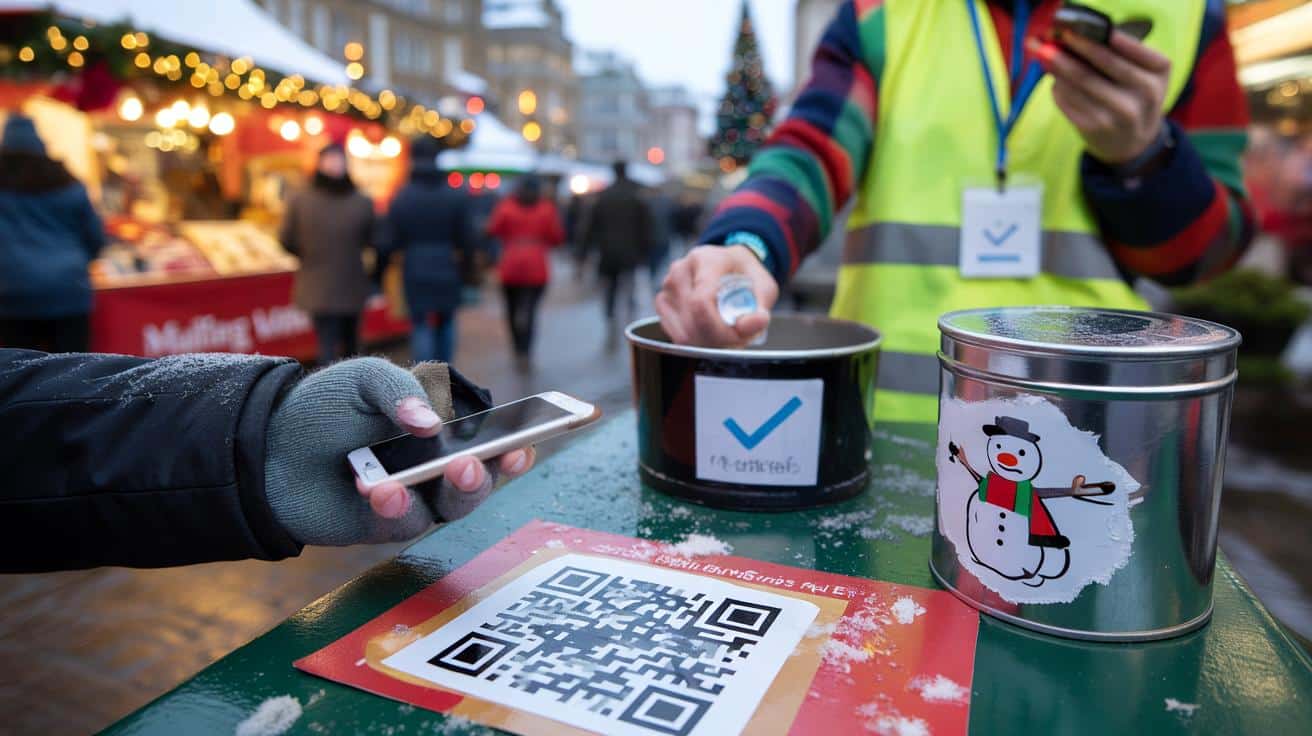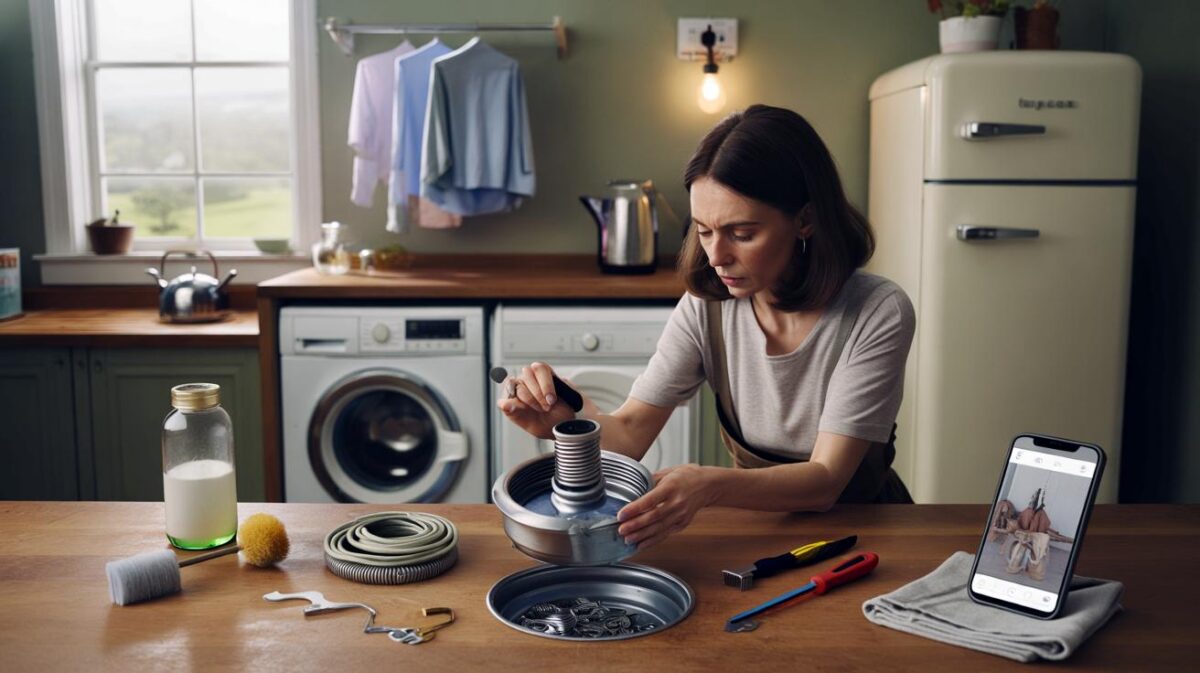It also brings slick fakes who borrow the language of kindness to siphon cash, data and trust. This guide is your quick scan in the glow of fairy lights, so your generosity lands where it’s meant to.
The queue snakes past the mulled wine stall, and a man in a novelty jumper rattles a tin with a snowman sticker. A QR code glints on a poster for a “children’s cancer appeal”, the sort of cause you don’t question, not at this time of year. You feel that warm fizz of wanting to help, thumb hovering over your phone camera.
Somewhere behind the music and tinsel is the small voice that asks, is this real. The people are rushing and you’re not built to doubt a smile. The sticker peeled at the corner.
Why the festive season is peak time for fake charities
Cold nights make quick judgments. Fake fundraisers know that the street is busy, that office parties blur details, that the kindness of crowds can be steered with a high-vis vest and a laminated lanyard. They pick names that echo real causes and mirror logos with just enough wobble to pass at a glance.
On a Saturday in Birmingham, a hospice poster was tagged with a fresh QR code that sent donors to a clone site. People scanned, donated £10, went back to their shopping. Action Fraud has logged thousands of reports linked to charity scams in recent years, and the winter spike is predictable. The hospice later posted a warning; the money was gone.
Scammers ride urgency and familiarity. They use seasonal hooks — “Christmas hampers”, “heating for pensioners”, “toy drives” — and they bloom on social media where a sad story can gather shares before checks kick in. Payment requests via bank transfer or crypto keep their trail faint. Trust is targeted because it’s fast.
Simple checks that keep your donation safe
Look for a registered charity and then look it up. In England and Wales, the register is on the Charity Commission website; in Scotland it’s OSCR; in Northern Ireland it’s CCNI. Match the charity’s full name, **Charity number**, and contact details with what you see on a bucket, email or page. If there’s a mismatch, pause.
Official fundraisers carry identity badges and many use the Fundraising Regulator’s **Fundraising Badge**. Check that badge on the regulator’s site, not through a link you were sent. If you’re donating online, type the web address yourself or use the charity’s main site to find its page on JustGiving, Enthuse or Virgin Money Giving. Two minutes to check can save a year of regret.
Pay in ways that give you recourse. Credit and debit cards offer chargeback; bank transfers to a person you don’t know do not. Tap-to-donate machines should display the charity’s name on screen, and you should receive a receipt by email or text that names the organisation clearly. If someone pushes you to donate with gift cards or crypto, step back.
Early warning signs, told through real habits
We’ve all had that moment where a story hits your chest and the logic comes a breath later. Scammers count on it. They lean on urgency — “we’re matching donations for the next 20 minutes” — and vague language — “help the children” with no place, programme or report. Names that are nearly-real, like “British Cancer Aid UK”, are a tell.
Let’s be honest: nobody really does that every day. Nobody reads every privacy notice, or searches the register on the pavement in the rain. Give yourself permission to slow the scene. Ask for the charity’s registered name, find a quiet corner, and donate directly through its official site. Your gift still lands today. It just lands where you meant it to.
This isn’t about being cynical. It’s about being steady.
“Give with your heart, check with your head. Pressure is a red flag; clarity is a green one.”
- Search the Charity Commission/OSCR/CCNI register and match the name and number.
- Type the URL yourself; don’t follow links in unsolicited messages.
- Ask for a receipt that names the charity; keep screenshots.
- Look for a real address and phone number on the site, not just a form.
- Avoid requests for bank transfer, crypto or gift cards.
How to give smarter without losing the festive glow
Generosity isn’t fragile. It gets stronger with small habits that put you in charge. Fakes thrive on speed and fog; you cut through both when you choose where and how to give, even if that means saying no in the moment and yes later at home. The cause will still need you tomorrow.
Consider giving through a route you already trust. Many UK charities list their donation platforms on their official sites and clarify how your **Gift Aid** is claimed — 25p is added by HMRC to every £1 you donate if you’re eligible and you tick the box. If someone can’t explain how Gift Aid works, or they try to claim it in your name without that yes, that’s another nudge to walk away.
Social posts can be real, and still risky. A heartfelt appeal on Instagram can sit two swipes from a spoof ad that sends you to a “.co” clone of a famous charity. Look for verified profiles and follow the money trail: where does the donate button take you, what’s on the receipt, whose bank is named. If you can’t answer, you can wait.
Give boldly, not blindly
There’s a quiet power in pausing. It keeps the season warm without letting it be naïve. Generosity is a muscle; it gets smarter when you engage it with questions a scammer can’t carry — specifics, receipts, accountability, a trace you can follow in January.
You won’t catch every disguise, and that’s okay. Make a plan for the causes you love, then leave a little space for serendipity on the street. When someone rattles a tin, kind eyes and a lanyard are a starting point, not an answer. A polite “I’ll donate through your website” is not a refusal, it’s care.
Real charities welcome scrutiny. They will tell you their number, their impact, their complaints process, their safeguarding policy, without bristle or bluster. Share these checks with your group chat, office Slack, family WhatsApp. The more of us who slow the scene, the fewer fakes get through.
| Key points | Detail | Reader Interest |
|---|---|---|
| Check the register | Match the charity’s full name and number on Charity Commission/OSCR/CCNI | Confident giving in seconds |
| Control the route | Type URLs yourself; use official pages and trusted platforms | Dodges clone sites and fake QR codes |
| Demand clarity | Legit fundraisers explain purpose, Gift Aid, and provide receipts | Peace of mind and traceable impact |
FAQ :
- How do I check if a UK charity is genuine?Search the official register: Charity Commission (England & Wales), OSCR (Scotland), or CCNI (Northern Ireland). Match the exact name, number, and contact details with what you’ve been given.
- Are contactless buckets and QR codes safe?They can be, if the screen shows the charity’s name and you receive a receipt naming that charity. Prefer codes found on the charity’s official materials or website over random stickers.
- What’s the safest way to donate on the spot?Use a card via the charity’s verified page, or ask for the registered name and donate directly through its website later. Avoid bank transfers to individuals, crypto and gift cards.
- Is Gift Aid real — and when should I tick it?Yes. If you’re a UK taxpayer and the donation is your own money, ticking Gift Aid lets the charity claim an extra 25p per £1 from HMRC. Read the declaration and keep a record.
- What if I think I gave to a fake?Contact your bank immediately to request a chargeback, report to Action Fraud, and notify the platform or charity being impersonated. Change any passwords you used and watch for follow‑up scams.








